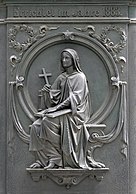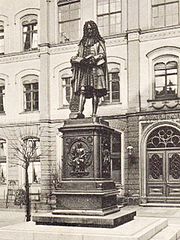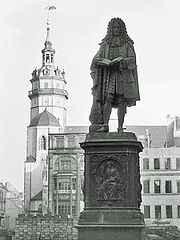Leibniz Monument (Leipzig)
The Leibniz Monument in the inner courtyard of the new campus of the University of Leipzig (Leibnizforum) honors the mathematician, philosopher, physicist, politician and diplomat Gottfried Wilhelm Leibniz (1646–1716), who was born on July 6, 1646 in Leipzig and studied at the local university. He is considered the universal scholar of his time, as one of the most important philosophers of the 17th and 18th centuries. Century and as an important pioneer of the Enlightenment .
The monument
Leibniz stands as a larger than life bronze statue on a square bronze pedestal . The base of the monument is made of granite . Although only associated with Leipzig in his youth, Leibniz, in contrast to Goethe in his monument on the Naschmarkt, is not depicted as a youth, but in the mature manhood in the costume of his time as the “Prince of Science”, who represents the union of theory and practice in aspired to all fields of science. He leans on a globe on the right as a symbol of power and holds an open book as a scholarly characteristic, which characterizes his historical scope for action.
- The faculties shown on the pedestal
To mark its extensive scientific importance, the four faculties of the university, which were common at the time, are depicted as female figures on four boards on the pedestal . In the philosophy on the front, the mirror serves as an attribute of self-knowledge and the owl as that of learning and knowledge. The jurisprudence on the left holding a law book, on which a scale is displayed. On the back, the theology is shown with a cross and open Bible. In the allegorical representation of medicine on the right, the Aesculapian snake , the symbol of medicine and medicine, drinks from a bowl.
"GOTTFRIED WILHELM LEIBNIZ." Is written above the front panel and "Erected in 1883." above the back panel.
history
In the 1840s, Leipzig academic circles came up with the idea of a Leibniz monument. The mathematician Moritz Wilhelm Drobisch (1802–1896) was a particular advocate . On June 11, 1846, the city council and the academic senate of the university issued a call for voluntary contributions for the construction of a Leibniz monument. The slowly growing foundation fund seemed sufficient to the council in 1869 to turn to the Dresden sculptor Ernst Hähnel (1811-1891) and seek advice about the Leibniz monument and one of Luther's monuments. After discussions about the location and other issues, the latter was finally executed as a Reformation monument on Hähnel's recommendation by Johannes Schilling (1828–1910), and Hähnel received the order for the Leibniz Monument, which he began to work on in 1881. The monument was cast by the Lenz art foundry in Nuremberg .
- Locations of the monument
On October 25, 1883, it was inaugurated in the Thomaskirchhof . It stood there for 13 years and in 1906 had to give way to the Bach monument by Carl Seffner (1861–1932), which was erected here in 1908. The Leibniz monument was placed in the Paulinerhof of the university, where it was positioned facing south in front of the Bornerianum . The memorial survived the bombing night of December 4, 1943 , and its surrounding buildings were now largely deprived of their surroundings on the former university grounds. Before the neighboring St. Pauli University Church was blown up on May 30, 1968, it was torn down and stored. After the university was rebuilt in the 1970s, the memorial was given a new location in 1977 between the lecture hall and Moritzbastei . After completion of the New Paulinum, it has been in the inner courtyard of the university, the Leibnizforum, since August 2008, near its former location, but now with a view to the east.
literature
- Markus Cottin, Gina Klank, Karl-Heinz Kretzschmar, Dieter Kürschner, Ilona Petzold: Leipzig monuments . tape 1 . Sax-Verlag, Beucha 1998, ISBN 3-930076-71-3 , p. 41/42 .
Web links
- Ursula Drechsel: The Leibniz Monument. In: Leipzig reading. Retrieved October 9, 2016 .
- Art treasures in the New Augusteum. Retrieved October 9, 2016 .
- Historic Leibniz sites. In: Website of the city of Leipzig. Retrieved October 9, 2016 .
Individual evidence
- ↑ according to University Rector Max Heinze in his speech on the unveiling of the monument on October 25, 1883 in the auditorium of the university
Coordinates: 51 ° 20 ′ 20.7 ″ N , 12 ° 22 ′ 42.6 ″ E









